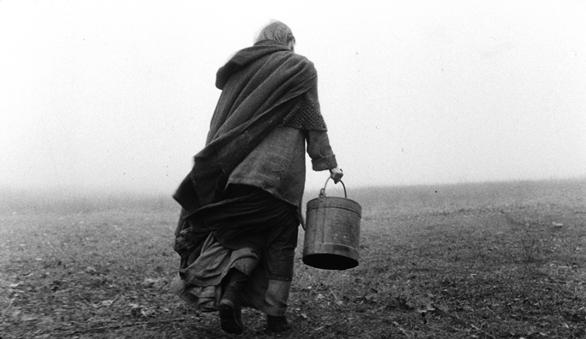“They think because they are afraid. To be afraid is to understand nothing.”
Hungarian director Bela Tarr’s perplexing masterpiece “Werckmeister Harmonies” is rightly terrifying, both as a challenging, endurance-testing art film and as an awe inspiring, devastating expression of filmmaking. It’s enormity, its profundity and its artistry provide for the film an immense metaphor for existence with no parallel.
Simply watching it is a captivating endeavor. Discussion of Tarr’s films always begin with mention of how few shots compose its running time (this one has a mere 39 at nearly two and a half hours), and watching its gradual dance in the most serene black and white cinematography is enchanting.
And yet understanding the gravity of Tarr’s metaphor is its own endeavor. “Werckmeister Harmonies” uses the appearance of a whale as part of a travelling circus as a way of equating third world war and rebellion with the tumultuous anarchy of the end of the world and such an occasion’s effect on the human psyche.
This is the sort of film that would make “The Tree of Life” haters reconsider their meaning of the word pretentious.
But the cinematic bravura of the film’s elegant opening sequence alone will soothe skeptics. The local paperboy Janos (Lars Rudolph) arranges three drunks in a pub to represent the movement of the Sun, the Earth and the Moon. He halts them in the position of a solar eclipse and laments the stopping of the world, of life and of light. And when all the drunks begin again in their celestial ballet, we realize the grace and tranquility of existence.
The scene is lovely. A gorgeous score by Mihaly Vig makes the moment wholly resounding. The camera captures close-ups, long shots and multiple perspectives without so much as an edit or a quick motion.
Tarr’s minimal editing and lengthy shots is common of Eastern European cinema, but his camera is mobile and stealthy. It hardly even resembles American filmmakers who experiment in extended takes, with the motion being contained to small rooms so that the camera can wonderfully embody the entire space rather than evade endlessly into a growing landscape.
And Tarr uses this confinement to his advantage in conveying his message. Consider the film’s third shot inside the home of Janos’s uncle Gyorgy (Peter Fitz), in which the camera begins and ends in the same living room as it follows Janos through daily routines of life. Like the Earth completing a revolution around the Sun, life goes on and the camera completes its own natural rotation.
But for all its stunning photography, “Werckmeister Harmonies” is a harrowing film. As the massive whale arrives in this small town, beaconing rumors of theft, disappearance and local turmoil, its gigantic container invades the entire frame as though blocking out the sun that would allow life to continue.
The activity in the town from here on out comes to a stand still, with crowds aimlessly flocking to the town square to be overwhelmed and confused by the whale’s purpose in their town. The bleak, foggy lighting of the film makes every moment seem monstrous and threatening, from a disturbing couple dancing at gunpoint to two children chillingly embodying their own anarchy as they shout and bang drums.
I confess that I did not grasp all of the film’s themes along with their images, but such moments like one of the film’s longest in which a mob invades and trashes a hospital, are some of the most immensely powerful singular shots I have ever seen, regardless of their meaning.
The one last thing I have still not attempted to explain is the film’s title. A Werckmeister harmony refers to a German composer who first imagined the idea of an octave, which the film argues contradicts with natural tonal progressions in the world. The character Gyorgy studies this intently, and his deep and complicated argument boils down to the idea that all the established principles of modern art are wrong.
Such can maybe also be said about Bela Tarr and “Werckmeister Harmonies,” a film so polarizing and resolutely different than most films ever made, it defies explanation in envisioning what a film can be and can evoke.
